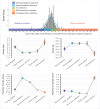Strength of selection in lung tumors correlates with clinical features better than tumor mutation burden
- PMID: 38831004
- PMCID: PMC11148192
- DOI: 10.1038/s41598-024-63468-z
Strength of selection in lung tumors correlates with clinical features better than tumor mutation burden
Abstract
Single nucleotide substitutions are the most common type of somatic mutations in cancer genome. The goal of this study was to use publicly available somatic mutation data to quantify negative and positive selection in individual lung tumors and test how strength of directional and absolute selection is associated with clinical features. The analysis found a significant variation in strength of selection (both negative and positive) among tumors, with median selection tending to be negative even though tumors with strong positive selection also exist. Strength of selection estimated as the density of missense mutations relative to the density of silent mutations showed only a weak correlation with tumor mutation burden. In the "all histology together" analysis we found that absolute strength of selection was strongly correlated with all clinically relevant features analyzed. In histology-stratified analysis selection was strongest in small cell lung cancer. Selection in adenocarcinoma was somewhat higher compared to squamous cell carcinoma. The study suggests that somatic mutation- based quantifying of directional and absolute selection in individual tumors can be a useful biomarker of tumor aggressiveness.
© 2024. The Author(s).
Conflict of interest statement
The authors declare no competing interests.
Figures



Similar articles
-
Frequent Mutations of POT1 Distinguish Pulmonary Sarcomatoid Carcinoma From Other Lung Cancer Histologies.Clin Lung Cancer. 2020 Nov;21(6):e523-e527. doi: 10.1016/j.cllc.2020.04.002. Epub 2020 Apr 15. Clin Lung Cancer. 2020. PMID: 32414627
-
Integrating Imaging, Histologic, and Genetic Features to Predict Tumor Mutation Burden of Non-Small-Cell Lung Cancer.Clin Lung Cancer. 2020 May;21(3):e151-e163. doi: 10.1016/j.cllc.2019.10.016. Epub 2019 Oct 25. Clin Lung Cancer. 2020. PMID: 31734072
-
Distinct profile of driver mutations and clinical features in immunomarker-defined subsets of pulmonary large-cell carcinoma.Mod Pathol. 2013 Apr;26(4):511-22. doi: 10.1038/modpathol.2012.195. Epub 2012 Nov 30. Mod Pathol. 2013. PMID: 23196793 Free PMC article.
-
[Clinicopathological study on primary lung cancer--immunohistochemical expression of p53 suppressor gene and bcl-2 oncogene in relation to prognosis].Rinsho Byori. 1996 Jan;44(1):32-41. Rinsho Byori. 1996. PMID: 8691638 Review. Japanese.
-
Personalized therapy on the horizon for squamous cell carcinoma of the lung.Lung Cancer. 2013 Jun;80(3):249-55. doi: 10.1016/j.lungcan.2013.02.015. Epub 2013 Mar 13. Lung Cancer. 2013. PMID: 23489560 Review.
References
MeSH terms
Substances
Grants and funding
LinkOut - more resources
Full Text Sources
Medical

